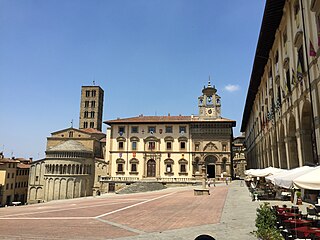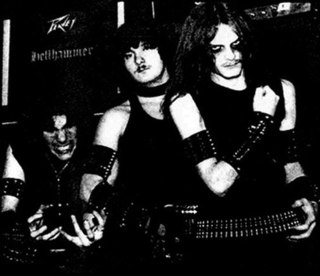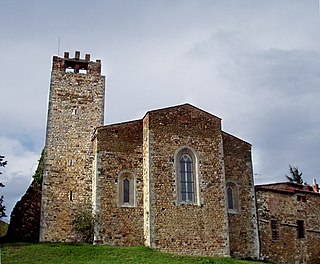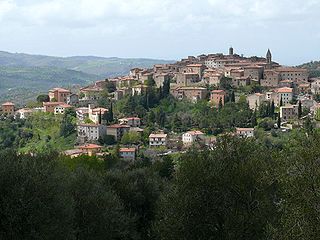Triumph of Death may refer to:

Arezzo is a city and comune in Italy and the capital of the province of the same name located in Tuscany. Arezzo is about 80 kilometres southeast of Florence at an elevation of 296 metres (971 ft) above sea level. As of 2022, the population was about 97,000.

Hellhammer was a Swiss metal band from Nürensdorf, active from 1982 to 1984. Although the band's sound and style were heavily criticized and poorly reviewed during their active years, they have been widely praised in retrospect and are often regarded as a key influence on black metal. In June 1984, Hellhammer disbanded but two of its members soon formed the influential extreme metal band Celtic Frost.

Pistoia is a city and comune in the Italian region of Tuscany, the capital of a province of the same name, located about 30 kilometres (19 mi) west and north of Florence and is crossed by the Ombrone Pistoiese, a tributary of the River Arno. It is a typical Italian medieval city, and it attracts many tourists, especially in the summer. The city is famous throughout Europe for its plant nurseries.

San Gimignano is a small walled medieval hill town in the province of Siena, Tuscany, north-central Italy. Known as the Town of Fine Towers, San Gimignano is famous for its medieval architecture, unique in the preservation of about a dozen of its tower houses, which, with its hilltop setting and encircling walls, form "an unforgettable skyline". Within the walls, the well-preserved buildings include notable examples of both Romanesque and Gothic architecture, with outstanding examples of secular buildings as well as churches. The Palazzo Comunale, the Collegiate Church and Church of Sant' Agostino contain frescos, including cycles dating from the 14th and 15th centuries. The "Historic Centre of San Gimignano" is a UNESCO World Heritage Site. The town also is known for saffron, the Golden Ham, pecorino cheese and its white wine, Vernaccia di San Gimignano, produced from the ancient variety of Vernaccia grape which is grown on the sandstone hillsides of the area.

The Collegiata di Santa Maria Assunta or Duomo di San Gimignano is a Roman Catholic collegiate church and minor basilica in San Gimignano, in Tuscany in central Italy. It contains important cycles of Renaissance frescoes by artists including Domenico Ghirlandaio, Benozzo Gozzoli, Taddeo di Bartolo, Lippo Memmi and Bartolo di Fredi. It falls within the UNESCO World Heritage Site of the "Historic Centre of San Gimignano", with its frescoes being described by UNESCO as "works of outstanding beauty".

Pescia is an Italian city in the province of Pistoia, Tuscany, central Italy.

Pienza is a town and comune in the province of Siena, Tuscany, in the historical region of Val d'Orcia. Situated between the towns of Montepulciano and Montalcino, it is considered the "touchstone of Renaissance urbanism".

Sorano is a town and comune in the province of Grosseto, southern Tuscany (Italy).

In works of art, the adjective macabre means "having the quality of having a grim or ghastly atmosphere". The macabre works to emphasize the details and symbols of death. The term also refers to works particularly gruesome in nature.

Massa Marittima is a town and comune of the province of Grosseto, southern Tuscany, Italy, 49 km NNW of Grosseto.

San Miniato is a town and comune in the province of Pisa, in the region of Tuscany, Italy.

Clusone is an Italian town and comune in the province of Bergamo, Lombardy, Italy. Located in the Val Seriana, it received the honorary title of city on 15 May 1957 with a presidential decree which ratified a Napoleon's promise of the year 1801. It is a member of the I Borghi più belli d'Italia association.

Campagnatico is a comune (municipality) in the Province of Grosseto in the Italian region Tuscany, located about 100 kilometres (62 mi) south of Florence and about 20 kilometres (12 mi) northeast of Grosseto in the valley of the Ombrone River.

Scarlino is a comune (municipality) in the Province of Grosseto in the Italian region Tuscany, located about 100 km (62 mi) southwest of Florence and about 25 km (16 mi) northwest of Grosseto.

Seggiano is a comune (municipality) in the Province of Grosseto in the Italian region Tuscany, located about 100 kilometres (62 mi) south of Florence and about 40 kilometres (25 mi) northeast of Grosseto.

Santa Donna Regina Vecchia is a church in Naples, in southern Italy. It is called Vecchia ("old") to distinguish it from the newer and adjacent church of Santa Maria Donna Regina Nuova.

A Madonna del Parto is an iconic depiction of the Virgin Mary shown as pregnant, which was developed in Italy, mainly in Tuscany in the 14th century. Examples include works by Taddeo Gaddi, Bernardo Daddi and Nardo di Cione, but the fresco by Piero della Francesca in the Museum of Monterchi, in the province of Arezzo, is considered the most famous one. The Madonna was portrayed standing, alone, often with a closed book on her stomach, an allusion to the Incarnate Word. These works were associated with the devotions of pregnant women, praying for a safe delivery. Sometimes, as with a statue by Sansovino in the Basilica of Sant'Agostino in Rome, the depiction is of a Virgin and Child, which was however known as a Madonna del Parto, because it was especially associated with devotions related to pregnancy. Here the Virgin wears the Girdle of Thomas, a belt of knotted cloth cord that was a relic held in Prato Cathedral, which many versions show her wearing.


Siena is a city in Tuscany, Italy. It is the capital of the province of Siena. Siena is the 12th largest city in the region by number of inhabitants, with a population of 53,062 as of 2022.

Paganico is a village in the province of Grosseto, in southern Tuscany, central Italy. It is a frazione of the comune of Civitella Paganico. It lies in the valley of the Ombrone river, at 66 meters above the sea level. In 2011 it had a population of 961 inhabitants.